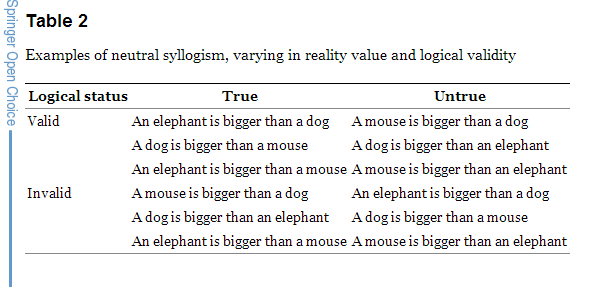In this mindware strategy tutorial you will learn how to:
- Separate out the truth of the sentences in an argument from the logical validity of the argument.
- ‘Bracket out’ the truth or falsehood of statements in an argument to overcome what is known as belief bias.
The following argument is a valid:
An elephant is bigger than a dog
A dog is bigger than a mouse.
————————-
Therefore, an elephant is bigger than a mouse
We know this because there can be no situation in which the first two sentences (the premisses) are true while the last sentence (the conclusion) is false.
Truth vs Logical Validity
In the next two problems, you had process in your working memory two things that have competed for your attention: the logical form of an argument, and the truth of the statements in the argument (called ‘truth values’).
In this argument the logic is good – it is a valid deductive inference – but the conclusion is false.
A mouse is bigger than a dog.
A dog is bigger than an elephant.
——————————————–
Therefore, a mouse is bigger than an elephant.
While in this example, the conclusion is true (cheetahs are of course faster than hedgehogs), but the argument is invalid.
A hedgehog is faster than a dog.
A dog is faster than a cheetah.
—————————————-
Therefore, a cheetah is faster than a hedgehog.
Here is a table showing the different combinations that are possible:
.
What Is Belief Bias?
Belief bias happens when you accept or reject an argument based on the believability of the conclusion (e.g. ‘an elephant is bigger than a mouse), not on the underlying logical form (validity) of the argument.
The logical form of an argument is independent from whether or not the premisses or conclusion are true or not.
For example, this argument is perfectly logically valid – even though none of it is true!
If cows can fly then I am married to Kate Middleton.
Cows can fly.
——————————-
Therefore I am married to Kate Middleton.
A logically valid deductive argument only requires that IF the premisses are true (considered hypothetically), the conclusion is also necessarily true.
Strategy Mindware Tip
Ensure that you evaluate the logical form of an argument separately from how you evaluate the truth of the premisses of the argument – or the truth of the conclusion.
Intelligence involves evaluating both the logical validity of inferences as well as the probability that a claim is true or not.



No comments yet.